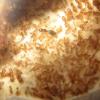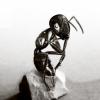Hey guys, I don't have any colonies now, but some of you may know that I gave away my Camponotus sp. colony to another local with the condition that he update me regularly on the progress of the colony.
In the most recent update, he said he threw in live mealworms into the outworld, and the workers actually waited until one of them shed their skin before attacking and eating it! I believe this is to avoid cutting through the hard exoskeleton, but I don't recall reading of this behavior before. Anyone noticed this interesting behavior in your colonies?
















